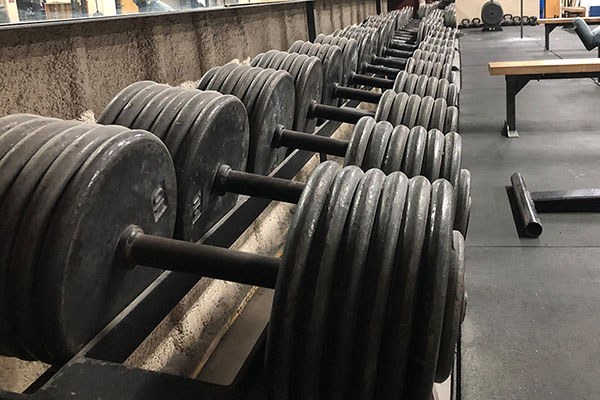
Dumbbells
by Mark Rippetoe | April 09, 2024
I have a large collection of
dumbbells in the gym. From 7 pounds to 128 pounds in relatively even
jumps of about 5 pounds (the dumbbells are marked with their actual
scale-measured weight, not the manufacturer’s best intentions), the
whole rack of 27 pairs represents a helluva lot of money spent a long
time ago, back when I thought they were useful. They really aren’t
that useful.
Dumbbells
are not stable in the hands in the same way a barbell is, since they
are not connected by a solid bar if both hands are involved. They can
move independently in all three axes, and stabilizing them is a
supposed feature of their use. It’s also a limiting factor in how
much weight you can use in each hand, if you’re pressing them either
on a bench or overhead. In other words, you can’t dumbbell bench or
press with half in each hand of what you can bench or press with a
bar.
But
pressing movements are not the only exercises you can use dumbbells
for. Dumbbell curls, dumbbell rows, dumbbell triceps kickbacks,
dumbbell flyes, dumbbell snatches, and probably several other
movements that do not constitute Strength Training can be performed
by sufficiently clever trainees trying to avoid having to put 5 more
pounds on their squat.
It’s
important to understand that the popular Alternate Dumbbell Presses
do not make your press stronger, and dumbbell flyes don’t make your
bench go up. In the case of dumbbell presses, human force production
against an external resistance is always at its maximum when exerted
bi-laterally – both sides working at the same time in the same
direction, like a deadlift. Unilateral force production is inherently
inefficient since the entire
body is not applying force against the resistance, and therefore not
as much force can be applied.
And
since the load is asymmetric, some of the muscle mass must be used to
restore the symmetry and balance
across the body as the load is moved. If you’re pressing a dumbbell
with your left hand, your right hand isn’t loaded and your right-side
leg and torso muscle is stabilizing
your left side – with muscle mass that could be used to
move the load if it
was in both hands.
In
the case of dumbbell flyes – no matter how they are performed –
the pressing function is omitted and the shoulder joint musculature
is all that is used. It is an intentionally inefficient exercise for
your favorite muscle group, your pecs. Muscle not loaded is muscle
not trained. More importantly, dumbbells are free to move in any
direction, and the only thing that controls them is you.
If the load is tied between your hands with a rigid bar, extraneous
movement is minimized and more of the force can be used to drive the
bar up. If the dumbbells can drift in any direction, some force that
could be used to drive them up must instead be used to keep them from
drifting, or hitting you in the head.
Strength
is the ability to produce force against an external resistance.
Both dumbbells and barbells are an external resistance. But since
force is measured by the weight you lift, barbells have the potential
to make you stronger, since you can lift heavier barbells than you
can dumbbells over the same range of motion. As a general rule, if
for some reason you want a heavier dumbbell bench press, get your
barbell bench press up and the heavier dumbbells will follow. It
doesn’t work the other way around.
So
much time and money have been wasted on dumbbell assistance exercises
over the decades that it makes my heart break to think that I might
have contributed to it. No novice lifter has any business doing
anything with a dumbbell, or any isolation exercise machine. If
you’re an intermediate or advanced lifter and you want to do some
“triceps” work – forgetting that your triceps get all the work
they can actually perform from the pressing movements – go ahead,
but don’t get too carried away. I know you like doing them, and the
muscle magazines have done their job so well that you cannot
completely de-program.
But
really, it’s very simple: nobody ever put 100 pounds on their bench
press with dumbbells, just like nobody ever put 100 pounds on their
squat with knee extensions. Just ask them. If they’re being honest,
they’ll tell you that no, my bench didn’t go up because I did
dumbbell benches – it went up because I put more weight on the bar
and benched it.
However,
I’m not getting rid of my dumbbell rack. It looks cool, and the north
wall would be empty without it.
Discuss in Forums
Credit : Source Post






